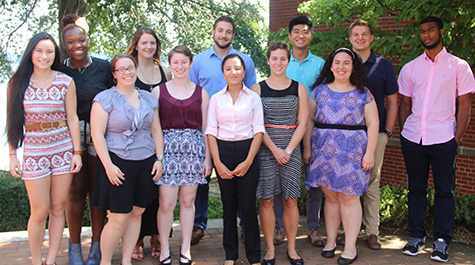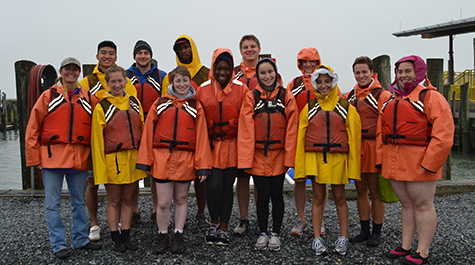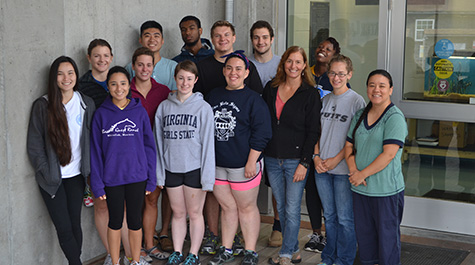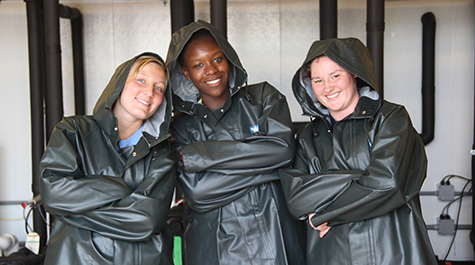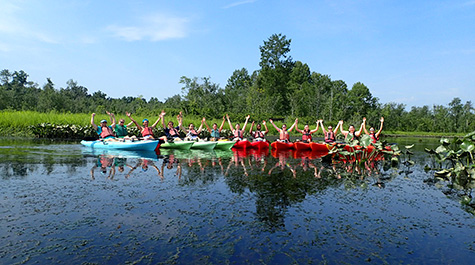VIMS provides marine research experience for undergraduates
Twelve undergraduates from across the nation have completed summer research at William & Mary's Virginia Institute of Marine Science and in early August presented their findings to an audience of faculty, staff and students.
The students are interns in the "Research Experience for Undergraduates" program at VIMS. Now in its 26th year, the internship offers highly individualized research experiences for a dozen standout college students. Directed by professor Rochelle Seitz, the program is funded by a National Science Foundation grant to Seitz and professor Linda Schaffner, with additional funding from VIMS, William & Mary, private donors and grants to individual faculty.
Participating in this year’s REU session, which was led by VIMS marine scientist Jenny Dreyer, were Kristen Bachand (Brown University); Haley Baker (University of Alabama); James Brown (Bates College); Ben Fowler (Juniata College); Nate Hua (University of Iowa); Shannon Jones (Northeastern University); Katherine Longmire (College of Charleston); Diana Lutz (Elmira College); Keiko Nomura (San Diego State University); Corelle Rokicki (Eckerd College); Justin Shawler (W&M); and Spencer Weinstein (University of Massachusetts Amherst).
"The REU program is a unique opportunity for undergraduates to conduct hands-on research in marine science with a mentor," says Seitz. "It really helps them start thinking about their future and the career they want to pursue."
Lutz, who worked with Professor Elizabeth Canuel and graduate student Amanda Knobloch to study how organic matter produced in marshes affects nearby estuarine waters and food webs, says, “My fellow interns and our mentors were all extremely fun, intelligent, and supportive. I really enjoyed the atmosphere at VIMS.”
Lutz says she applied to this program in an effort to get more work experience and knowledge to help her in her future. “This opportunity will help me decide on a field to ultimately go into, or simply allow me to gain much-needed skills.”
Brown — who hails from Norfolk — says his interest in the role math and physics play in marine science led him to apply for the internship. “The program was a good opportunity to learn more about the field of marine science, and it was great that it was so close to home.”
Fowler says he heard about the program while attending a conference last January where he met VIMS professor Kim Reece. Reece — who served as Fowler’s mentor along with scientist Gail Scott — worked with Fowler on a project that used pulsed-field gel electrophoresis of environmental bacteria to better understand how they interact with Chesapeake Bay oysters.
“I liked having the flexibility to design the study,” says Fowler. “I also really enjoyed learning new skills in microbiology and real-time PCR [polymerase chain reaction].”
Brown says having the opportunity to work in an applied math and physics lab was his favorite aspect of the internship. Brown worked with professor Donglai Gong and graduate student Daniel Wang to examine the exchange of heat and salt between the relatively shallow waters of Virginia’s continental shelf and the deeper waters of the open ocean. “I also really appreciated the opportunity to step out of the lab and get involved with field work,” he says.
Baker says she was familiar with VIMS’ reputation as a leading marine science institution prior to the program, and when she heard about the internship she couldn’t pass it up. “The aspect I enjoyed most about the program was the Alternatives to Academia panel,” she says. “It was so interesting to hear about career options in the field of marine science outside of working at a university. I really enjoyed hearing everyone’s stories.”
The VIMS REU program is one of the longest-standing and most successful REU programs in the nation, with more than half its participants going on to study marine science in graduate school.
"Our program gives students get a chance to complete a research project, figure out what their results mean, and present those findings to others," says Program Coordinator Jenny Dreyer. "It's a smaller version of the work that happens every day at VIMS. Students walk away with a realistic view of what it means and what it takes to be a research scientist."
Student Projects
- Kristen Bachand (Brown University): Salt marsh pattern formations: Effects on ribbed mussel and marsh grass densities. Mentors: Mandy Bromilow, Danielle McCulloch, Professor Rom Lipcius.
- Haley Baker (University of Alabama): Counting chromosomes: Testing the effect of mosaic and non-mosaic tetraploid parents on triploid offspring of the American oyster. Mentors: Professor Stan Allen, Joana Sousa
- James Brown (Bates College): Exchanges of heat and salt across the Mid Atlantic Bight shelf-break from the ROMS ESPRESSO Model. Mentors: Daniel Wang, Professor Donglai Gong.
- Ben Fowler (Juanita College): Pulsed-field gel electrophoresis of environmental Vibrio parahaemolyticus strains from Chesapeake Bay oysters. Mentors: Professor Kim Reece, Gail Scott.
- Nate Hua (University of Iowa): Impacts of microplastic and PCB pollution on microbial denitrification and community structure. Mentors: Professor Bongkeun Song, Ashley Smyth.
- Shannon Jones (Northeastern University): Toxic growth: Changes in growth and toxin production in Alexandrium fundyense when grown on nitrate, ammonium and urea sources. Mentors: Professor Juliette Smith, Taylor Armstrong.
- Katherine Longmire (College of Charleston): The effects of ocean acidification on Mya arenaria and predator-prey interactions. Mentors: Cassie Glaspie, Professor Rochelle Seitz.
- Diana Lutz (Elmira College): Analysis of fluorescent dissolved organic matter (fDOM) at the marsh estuarine interface.Mentors: Professor Elizabeth Canuel, Amanda Knobloch.
- Keiko Nomura (San Diego State University): Drivers of marine spatial management in Japan. Mentors: Andrew Scheld, David Kaplan, Jennifer Beckensteiner.
- Corelle Rokicki (Eckerd College): In vivo replication kinetics in rainbow trout (Oncorhynchus mykiss) of infectious hematopoietic necrosis virus and Flavobacterium psychrophilum. Mentors: Andrew Wargo, Darbi Jones
- Justin Shawler (W&M): Drowning coasts: A multi-proxy view of anthropogenic changes in coastal sediment supply at Joppa Flats, Massachusetts. Mentor: Christopher Hein














